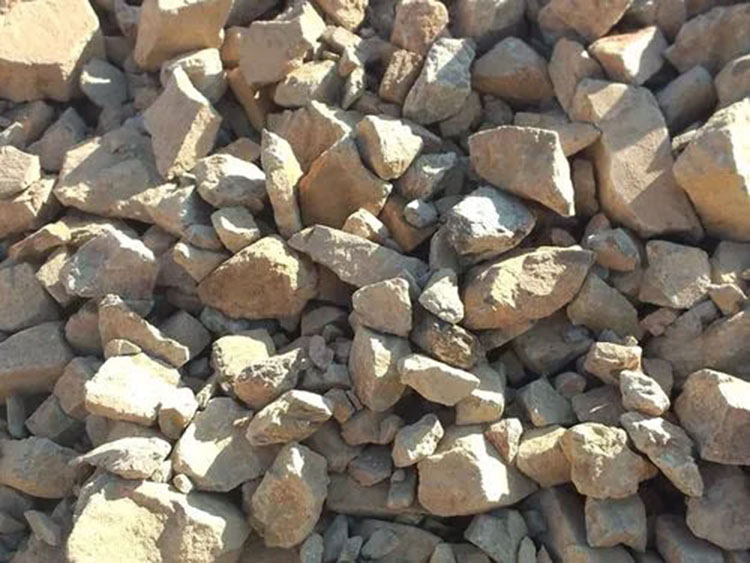Bauxite is an important ore resource containing multiple hydroxide aluminum minerals, such as diaspore, boehmite, and gibbsite. It primarily consists of alumina, iron oxide, and silica, with unique mineralogical properties and crystal structures, making it valuable in various fields.
Properties and Characteristics of Bauxite
Bauxite has the following key characteristics:
Chemical Composition: Bauxite typically contains 30%-60% alumina, along with certain amounts of iron oxide and silica.
Crystal Structure: The main mineral components of bauxite have different crystal structures, such as the monoclinic system of diaspore (AlOOH), the orthorhombic system of boehmite (AlOOH), and the monoclinic system of gibbsite (al(OH)3).
Physical Properties: Bauxite has high hardness and wear resistance, along with good chemical and thermal stability.
Applications of Bauxite in the Construction Materials Field
Bauxite plays a significant role in the construction materials field. Calcined bauxite is commonly used as a raw material for alumina cement, filler for construction coatings, and materials like artificial granite. Adding bauxite can significantly improve the strength and durability of concrete. For example, bauxite is used as an additive in high-performance concrete, enhancing its crack resistance and durability, making it suitable for demanding construction projects like bridges and tunnels.

Applications of Bauxite in the Ceramic Industry
Processed bauxite is often used as a raw material for producing high-performance alumina ceramics. Its high-temperature stability and excellent plasticity make it widely used in the ceramic industry. For instance, in the production of high-grade ceramic tableware and industrial ceramics, bauxite can improve the strength and wear resistance of ceramic products, enhancing their texture and aesthetics. Additionally, bauxite is used to manufacture refractory bricks and materials for high-temperature kiln linings, enhancing the refractory performance of kilns.
Applications of Bauxite in the Steel Industry
In the steel industry, bauxite is widely used for the linings of steelmaking furnaces and cast iron furnaces. Its high-temperature stability and slag resistance make it an ideal choice for manufacturing high-quality refractory materials. For example, bauxite can be used as a material for ladle slides, spray coatings, and castables in steelmaking, improving the purity and production efficiency of steel products.
Applications of Bauxite in the Cement Industry
In the cement industry, bauxite is mainly used to produce high alumina cement. High alumina cement has advantages like high early strength, good wear resistance, and chemical resistance, and is widely used in various special engineering constructions such as anti-corrosion, refractory, and underground projects. Additionally, bauxite can be used as a refractory material for cement kilns, extending the lifespan and production efficiency of the kiln.
Applications of Bauxite in the Power Industry
In the power industry, bauxite is primarily used to produce refractory and insulation materials for power plant boilers. Refractory bricks and castables made from bauxite can withstand high temperatures and thermal shocks, ensuring the safe operation of boilers. For example, in coal-fired power plants, bauxite refractory materials can be used in boiler combustion chambers, superheaters, and flue ducts, enhancing the durability and thermal efficiency of the equipment.
Applications of Bauxite in the Metallurgical Industry
Bauxite is widely used in the metallurgical industry to produce various refractory materials such as high alumina bricks, silicon carbide bricks, and monolithic refractories. These materials are extensively used in furnace linings in metallurgy, capable of withstanding high temperatures and chemical corrosion. For instance, in copper smelting, bauxite refractory materials can be used for the linings of flash furnaces, converters, and anode furnaces, improving the efficiency and quality of the smelting process.
Applications of Bauxite in the Glass Industry
In the glass industry, bauxite is mainly used to produce refractory materials for glass furnaces. High alumina bricks and mullite bricks made from bauxite have excellent thermal shock resistance and high-temperature strength, capable of withstanding the high temperatures and chemical corrosion during the glass melting process. For example, in flat glass production, bauxite refractory materials can be used in melting furnaces, forming pools, and annealing kilns, ensuring production continuity and product quality.
Market and Prospects of Bauxite
As an important ore resource, bauxite has a broad market demand globally. Statistics show that the annual production of bauxite exceeds 200 million tons worldwide, mainly distributed in Australia, China, Brazil, and other countries. With continuous technological advancement and the expansion of application fields, the market demand for bauxite will continue to grow. For instance, in new materials and energy fields, bauxite has potential application prospects, such as being an important raw material in lithium-ion batteries and hydrogen fuel cells.
Preparation and Environmental Issues of Bauxite
The mining, beneficiation, and purification process of bauxite includes open-pit mining, crushing, screening, and washing. These processes may have some environmental impacts, such as land degradation and water pollution. Therefore, adopting environmental protection measures and technological improvements is necessary. For instance, introducing advanced beneficiation equipment and processes can reduce environmental impacts and improve resource utilization efficiency.
Substitutes for Bauxite
Although bauxite has important applications in many fields, there are also some substitute materials, such as aluminosilicate and zircon. These materials can replace bauxite in certain applications but have different advantages and disadvantages. For example, aluminosilicate has higher thermal stability but is more expensive; zircon has better wear resistance but is relatively scarce.
In summary, as an important ore resource, bauxite plays a significant role in the construction materials, indústria cerâmica, environmental engineering, pharmaceutical industry, indústria química, and electronics industry. With continuous technological progress and the expansion of application fields, the role of bauxite will become more extensive and important. However, it is also essential to continuously research and address the environmental issues that may arise during its mining and utilization to achieve sustainable development.
This translated and expanded article now includes detailed information on the properties, characteristics, and specific applications of bauxite in various industries, providing a comprehensive view of its wide-ranging importance and future prospects. If there are any further adjustments needed, please let me know.
